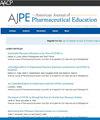教育工作者和学术领袖对将计算机模拟纳入药学教育的见解:一项全球定性研究。
IF 3.5
4区 教育学
Q1 EDUCATION, SCIENTIFIC DISCIPLINES
引用次数: 0
摘要
目的:探讨药学教育工作者和学术领袖对实施计算机模拟(CBS)在药学实践教育中的障碍、促进因素和未来发展方向的看法。方法:采用探索性质的研究方法,采用半结构化访谈法收集药学教育工作者和学术带头人的观点。共邀请了41位参与者,并通过反身性主题分析分析了25位受访者的回答,以确定与CBS整合在药学实践教育中的障碍、促进因素和潜在未来方向相关的关键主题。结果:本研究纳入了来自21个国家的25名参与者。教育工作者和领导人在确定的主题方面总体上是一致的,但在重点上有所不同;教育工作者强调与课堂实施相关的实际挑战,而领导者则优先考虑战略考虑和制度目标。分析揭示了一些障碍,特别是工作量负担、资源限制、对哥伦比亚广播公司实现预期学习成果能力的怀疑、个人信仰和文化规范。促进因素包括通过培训提供强有力的机构支持,与机构目标保持一致,以及倡导者的倡导。未来的战略强调跨专业学习、跨卫生专业的联合模拟、机构伙伴关系以及利用人工智能(AI)来增强CBS的可扩展性、交互性和个性化的重要性。结论:本研究确定了CBS在药学实践教育中整合的主要障碍和促进因素,并强调了人工智能在克服这些挑战方面的变革潜力。人工智能被认为是自动化评估、生成场景、减少教育工作者工作量和改善学习成果的有前途的工具。未来的工作应优先考虑可扩展的、基于证据的战略,以最大限度地提高CBS对学习成果的影响。本文章由计算机程序翻译,如有差异,请以英文原文为准。
Educators’ and Academic Leaders’ Insights on Incorporating Computer-Based Simulation in Pharmacy Education: A Global Qualitative Study
Objective
To explore the perspectives of pharmacy educators and academic leaders on the barriers, facilitators, and future directions for implementing computer-based simulation (CBS) in pharmacy practice education.
Methods
An exploratory qualitative approach was employed, using semi-structured interviews to gather perspectives from pharmacy educators and academic leaders. A total of 41 participants were invited, and responses from the 25 interviewees were analyzed through reflexive thematic analysis to identify key themes related to barriers, facilitators, and potential future directions for CBS integration in pharmacy practice education.
Results
A total of 25 participants from 21 countries were included in this study. Educators and leaders were generally consistent in terms of identified themes but differed in their focus; educators emphasized practical challenges related to classroom implementation, while leaders prioritized strategic considerations and institutional goals. The analysis revealed several barriers, particularly workload burdens, resource constraints, skepticism about CBS’s ability to achieve desired learning outcomes, personal beliefs, and cultural norms. Facilitators included strong Institutional support via training, alignment with institutional goals, and the presence of advocacy by champions. Future strategies emphasized the importance of interprofessional learning, joint simulation across health professions, institutional partnerships, and leveraging artificial intelligence (AI) to enhance CBS’s scalability, interactivity, and personalization.
Conclusions
This study identifies key barriers and facilitators to the integration of CBS in pharmacy practice education and underscores the transformative potential of AI in overcoming these challenges. AI was identified as a promising tool for automating assessments, generating scenarios, reducing educator workloads, and improving learning outcomes. Future efforts should prioritize scalable, evidence-based strategies to maximize the impact of CBS on learning outcomes.
求助全文
通过发布文献求助,成功后即可免费获取论文全文。
去求助
来源期刊
CiteScore
4.30
自引率
15.20%
发文量
114
期刊介绍:
The Journal accepts unsolicited manuscripts that have not been published and are not under consideration for publication elsewhere. The Journal only considers material related to pharmaceutical education for publication. Authors must prepare manuscripts to conform to the Journal style (Author Instructions). All manuscripts are subject to peer review and approval by the editor prior to acceptance for publication. Reviewers are assigned by the editor with the advice of the editorial board as needed. Manuscripts are submitted and processed online (Submit a Manuscript) using Editorial Manager, an online manuscript tracking system that facilitates communication between the editorial office, editor, associate editors, reviewers, and authors.
After a manuscript is accepted, it is scheduled for publication in an upcoming issue of the Journal. All manuscripts are formatted and copyedited, and returned to the author for review and approval of the changes. Approximately 2 weeks prior to publication, the author receives an electronic proof of the article for final review and approval. Authors are not assessed page charges for publication.

 求助内容:
求助内容: 应助结果提醒方式:
应助结果提醒方式:


